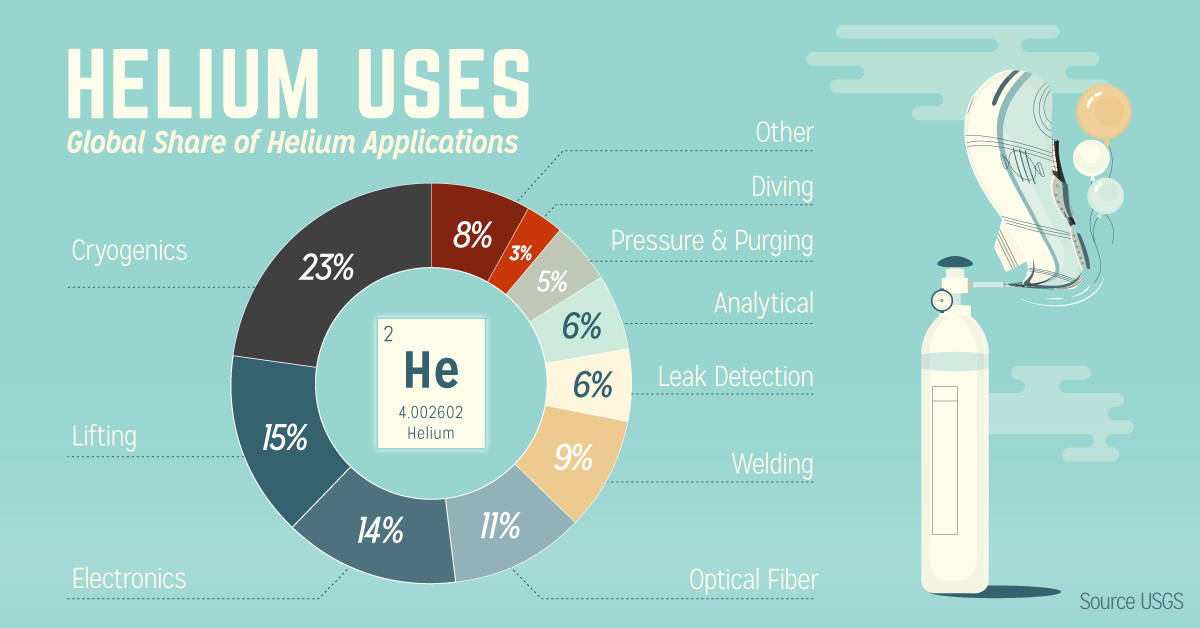- Helium 3 On Earth
- Where Can You Find Helium On Earth
- Helium Left On Earth
- Who Discovered Helium On Earth

Helium is one of the most common elements in the universe. It is called a noble gas because it doesn’t chemically interact with elements. Its atomic number is 2 and the weight is 4.002. In its natural state, it doesn’t have any smell, taste or color.
Helium is the second most abundant element in the universe, but here on earth, it's rather rare. Most people guess that we extract helium from the air, but actually we dig it out of the ground. Helium can be found in certain parts of the world, notably in Texas, as a minor component in. The Age of the Earth’s Atmosphere (Institute for Creation Research, San Diego), p. 23 Return to text. The escape of helium from the earth’s atmosphere. Reviews of Geophysics and Space Physics 1:305–349. The escape of helium from the earth’s atmosphere. Helium makes up about 0.0005% of the earth's atmosphere. This trace amount of helium is not gravitationally bound to the earth and is constantly lost to space. The earth's atmospheric helium is replaced by the decay of radioactive elements in the earth's crust. Alpha decay, one type of radioactive decay, produces particles called alpha particles.
Common Uses of Helium
Evidence shows that the human voice can be changed with a bit of helium. The gas is also used as light weight aircraft fuel. The element is usually combined with hydrogen in air balloons. Hydrogen alone is fine, but helium makes the balloon safer to use. The same gas is used by caisson workers too. Divers use oxygen and helium during their dives. The combination provides them with the atmosphere necessary to survive in high pressure environments.
Medical Applications
Helium can also be used for breathing observation. It is essential in treating ailments asthma, emphysema and other conditions that affect breathing. The gas is usually used to treat diseases that affect the lungs. Hospital MRI scans relies on liquefied helium. When the element is set at -269 C (the low boiling point), it becomes usable in MRI magnet cooling down.
Acute and chronic forms of respiratory ailment treatments have helium components. In almost all cases, oxygen and helium are used together. This combination gets to the lungs much quicker. Helium in different forms and combinations are used in medical instrumentations and nuclear medicine.
Welding and Magnet Production
Helium is used to cool down superconduction magnets. This is required during their operation. Welding companies also rely on it to provide protection. It is used the same way in the development of titanium, zirconium, germanium and silicon.
Other Applications
Hydrogen and oxygen are often used as rocket fuel. Helium-neon lasers use the element extensively. These instruments are used for barcode reading. The same element is needed to monitor small fractures in ships and other vehicles.
Helium dating is relied on to date rocks that contain uranium and titanium. The gas is used for protection during germanium crystal and silicon production. It is valued as a protective gas because of its inert nature.
Helium’s properties also make it ideal for observation in quantum mechanics. Its structure is basic and easy to study. Numerous mathematical processes are used to assess subatomic particle behavior. Using these techniques, neutrons, electrons and protons can be studied. However, these tests cannot determine their actions 100% accurately. This is due to the nature of quantum mechanics.

Uses of Helium in Space Technology
NASA space programs use the gas to fuel their shuttles. Liquid fuels are volatile. They are packed with corrosive material that could destroy a spacecraft’s casing. To avoid this problem, a craft is filled with helium gas. The same process is used in blimps and air balloons. It is preferred to hydrogen for two reasons. It is lighter and not flammable. The element is also used to keep nuclear reactors cool.
Occurrence and Discovery
Helium can be found all over the universe, although it isn’t widely distributed on Earth. Its most frequent form is gas. It shares many characteristics with other noble gases. Helium doesn’t form compounds easily with other elements. It is also very stable. But as the facts earlier show, the element is very usable. Its symbol in the periodic table is He. Its stability and non-reactive nature makes it the perfect tool for handling unstable materials. The element was discovered in 1868 during a solar eclipse. It took scientists 30 years to extract and isolate the gas from the clevite mineral.
The gas is not prevalent on Earth. It is usually extracted from natural gas. The typical amount found ranges from 2 to 7%. It didn’t take long for governments to realize its usefulness in military operations. Access to it was restricted during the two World Wars. In its purest form, the element doesn’t pose any health risks.
However, inhaling excessive amounts has its risks. The danger is the gas functions as an asphyxiate. Inhaling helium from pressure tanks can damage the lungs. The variants found in weather balloons may have other elements that are unhealthy to breathe.
Properties
Helium 3 On Earth
Its atomic number indicates there are two electrons and two protons in a neutral helium atom. Its most vital properties are density, melting and boiling points, state of matter and atomic mass. The density is 101.325 kilopascals (kPa) and 0.1786 grams per liter at 32°F (0.0°C). Its atomic mass is 4.0026 grams per mole.
Solid and liquid helium can only manifest in high and low temperature settings. Either condition cannot manifest under normal pressures. -458 F (0.95 Kelvin) is the melting point. The boiling point is -452°F (4.22 Kelvin).
One of the more interesting uses of helium is in cryogenics. This field is concerned with low temperature phenomena and its production. Most of the helium produced today is used for cryogenics.
The Element Helium
[Click for Isotope Data]


Atomic Number: 2
Atomic Weight: 4.002602
Melting Point: 0.95 K (-272.2°C or -458.0°F)
Boiling Point: 4.22 K (-268.93°C or -452.07°F)
Density: 0.0001785 grams per cubic centimeter
Phase at Room Temperature: Gas
Element Classification: Non-metal
Period Number: 1
Group Number: 18
Group Name: Noble Gas
What's in a name? For the Greek god of the sun, Helios.
Where Can You Find Helium On Earth
Say what? Helium is pronounced as HEE-lee-em.
History and Uses:
Helium, the second most abundant element in the universe, was discovered on the sun before it was found on the earth. Pierre-Jules-César Janssen, a French astronomer, noticed a yellow line in the sun's spectrum while studying a total solar eclipse in 1868. Sir Norman Lockyer, an English astronomer, realized that this line, with a wavelength of 587.49 nanometers, could not be produced by any element known at the time. It was hypothesized that a new element on the sun was responsible for this mysterious yellow emission. This unknown element was named helium by Lockyer.
Helium Left On Earth
The hunt to find helium on earth ended in 1895. Sir William Ramsay, a Scottish chemist, conducted an experiment with a mineral containing uranium called clevite. He exposed the clevite to mineral acids and collected the gases that were produced. He then sent a sample of these gases to two scientists, Lockyer and Sir William Crookes, who were able to identify the helium within it. Two Swedish chemists, Nils Langlet and Per Theodor Cleve, independently found helium in clevite at about the same time as Ramsay.

Helium makes up about 0.0005% of the earth's atmosphere. This trace amount of helium is not gravitationally bound to the earth and is constantly lost to space. The earth's atmospheric helium is replaced by the decay of radioactive elements in the earth's crust. Alpha decay, one type of radioactive decay, produces particles called alpha particles. An alpha particle can become a helium atom once it captures two electrons from its surroundings. This newly formed helium can eventually work its way to the atmosphere through cracks in the crust.
Helium is commercially recovered from natural gas deposits, mostly from Texas, Oklahoma and Kansas. Helium gas is used to inflate blimps, scientific balloons and party balloons. It is used as an inert shield for arc welding, to pressurize the fuel tanks of liquid fueled rockets and in supersonic windtunnels. Helium is combined with oxygen to create a nitrogen free atmosphere for deep sea divers so that they will not suffer from a condition known as nitrogen narcosis. Liquid helium is an important cryogenic material and is used to study superconductivity and to create superconductive magnets. The Department of Energy's Jefferson Lab uses large amounts of liquid helium to operate its superconductive electron accelerator.
Helium is an inert gas and does not easily combine with other elements. There are no known compounds that contain helium, although attempts are being made to produce helium diflouride (HeF2).
Estimated Crustal Abundance: 8×10-3 milligrams per kilogram
Estimated Oceanic Abundance: 7×10-6 milligrams per liter
Number of Stable Isotopes: 2 (View all isotope data)
Ionization Energy: 24.587 eV
Oxidation States: 0
Electron Shell Configuration: | 1s2 |
Who Discovered Helium On Earth
For questions about this page, please contact Steve Gagnon.
